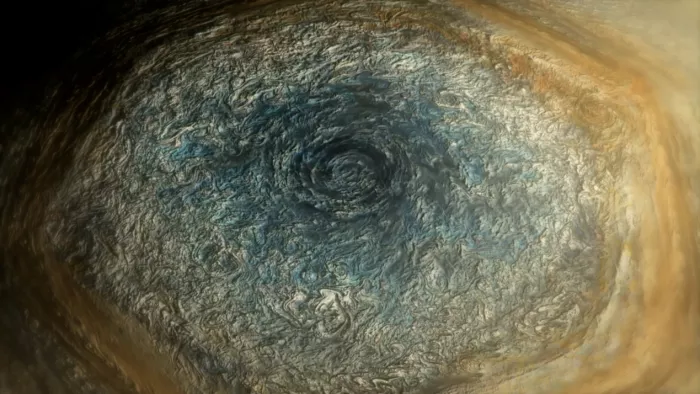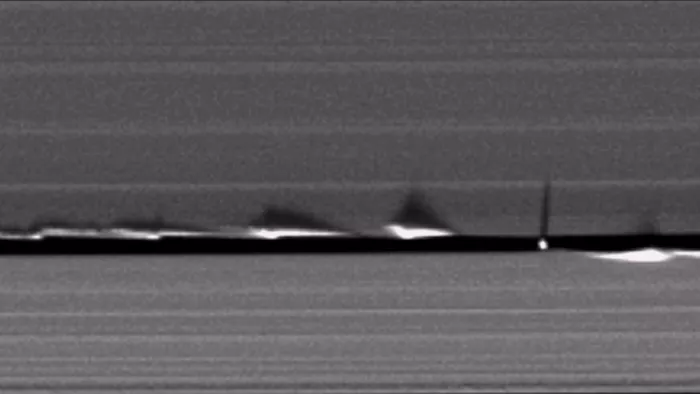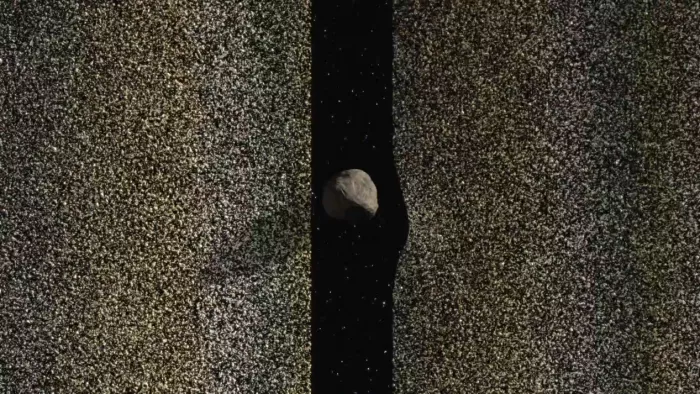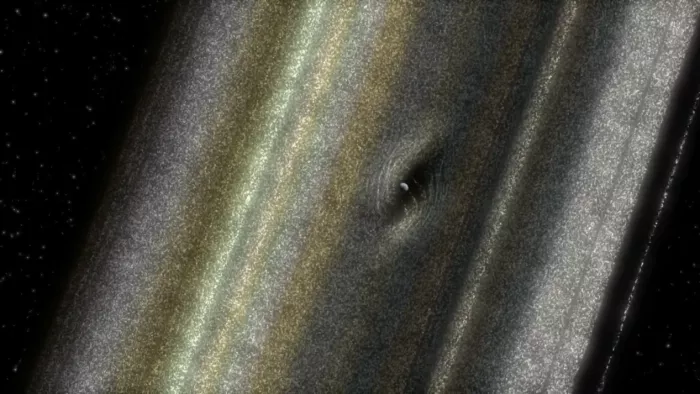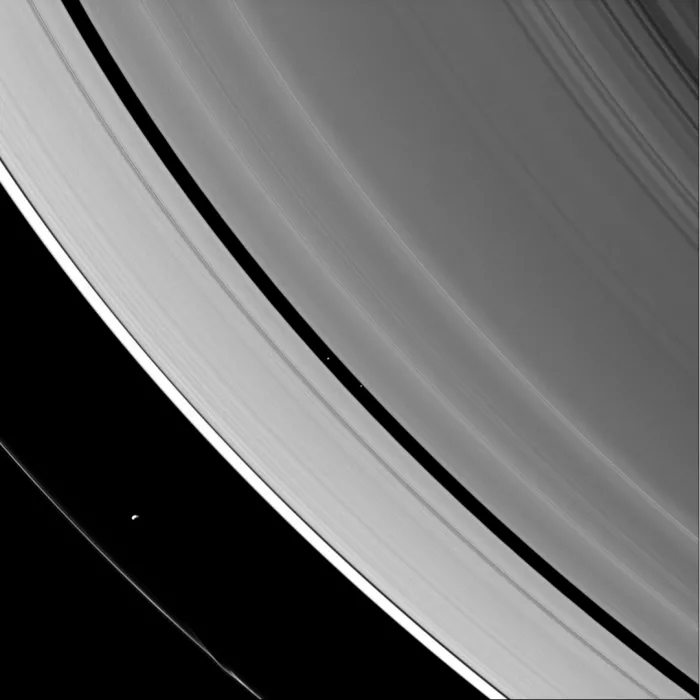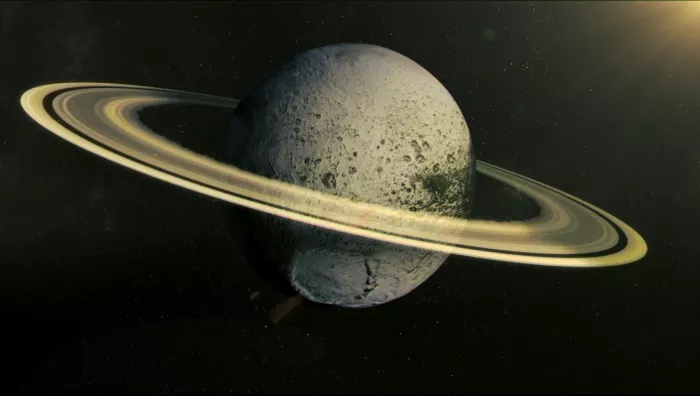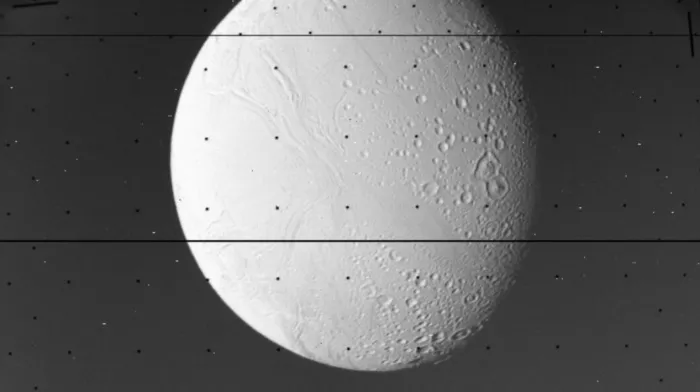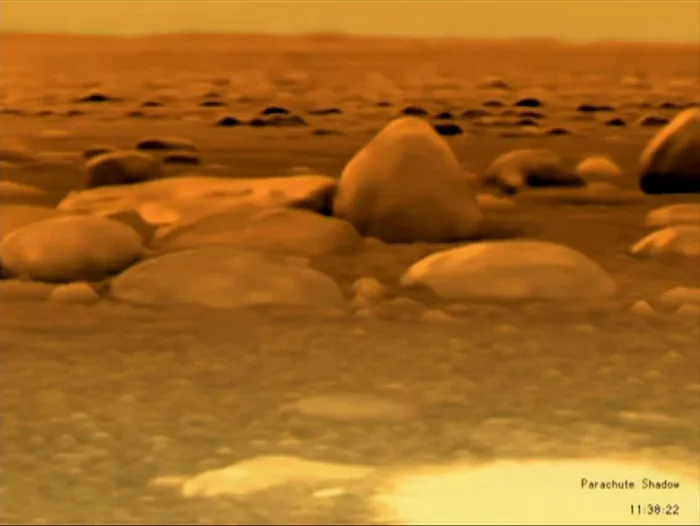Saturn must be the most beautiful planet in the solar system This is a planet surrounded by multiple satellites and multiple rings. It is like a miniature solar system. The planet also attracts scientists In October 1997, NASA, the European Space Agency and the Italian Space Agency cooperated in the Saturn exploration project and launched the Cassini interstellar probe.
The probe is named after Italian born French astronomer Giovanni Domenico Cassini. Its mission is to fly around Saturn and conduct in-depth investigation of Saturn and its atmosphere, rings, satellites and magnetic field.
Cassini interstellar probe
After six years, eight months and 3.5 billion kilometers of long space travel, it successfully entered the orbit around Saturn at 12:12 Beijing time on July 1, 2004.
Over the next 13 years, Cassini allowed scientists to discover things they had never imagined and unveiled Saturn's mystery.
Cassini took close-up shots of the planet's gas surface, showing a turbulent and stormy world.
People who have experienced hurricanes on earth know that some storms on earth are particularly violent. However, when compared with the storms on Saturn, those storms are just breeze.
On Saturn, there is a storm that makes scientists feel very strange, because the location of the storm shows a unique shape - a hexagonal ring
Storms with hexagonal rings at Saturn's poles
No one expected a storm with a hexagonal ring. During Cassini's lifetime, many hexagonal images were taken.
Every time scientists post a hexagonal image on the website, the click through rate of the website soars. Not only ordinary people, but even scientists were shocked when they first saw this.
Who can imagine such a regular thing in the atmosphere of a planet, almost geometric?
Cassini data show that the hexagonal storm may be a towering structure hundreds of miles high It's a huge structure. It's thousands of miles wide.
At the center, the pole, is a permanent vortex - a permanent hurricane.
It's like a creepy eye staring at us all the time.
Each side of the hexagon is as wide as the earth, which looks artificial
How do hexagonal storms or cloud structures on Saturn form?
Scientists believe that Saturn's rotation and airflow interact to form this symmetrical shape. But they don't know why it lasts for decades. It's a mystery.
Although the shape of the hexagon is stable, the color has changed. In more than four years, it changed from blue to gold.
This shift is related to Saturn's season. The season on Saturn is the same as that on earth, which is the inclination of the planet.
So when Saturn revolves around the sun, its north pole tilts towards the sun. In this way, more light can be obtained there. Sunlight interacts with the atmosphere to produce suspended particles, called aerosols.
So over time, the hexagon changed from blue to orange, and the color change took place one summer in Saturn's northern hemisphere. But mysteriously, the center of the hexagon is still blue.
There may be two reasons for this.
One reason is that perhaps because the "eyes" are blocked and can not shine on the sun, there is no haze in the "eyes". The sun is responsible for the brown haze we see on Saturn.
The second reason may also be the real reason: the vortex is sucking down the haze. There may be something similar to the hurricane eye. There is a layer of mist on it, but it will be sucked into the "eye".
But the hexagonal ring storm on Saturn is not the only unusual thing in Saturn's weather.
[rain will fall from space to the planet]
In April 2017, Cassini dived between Saturn's rings along a bold new path. Go to a place where no spacecraft has flown before and make a unique set of measurements.
This is an unknown field. Scientists don't know what they will find. There may be materials that can destroy the Cassini spacecraft.
However, something unexpected happened to scientists again Cassini found that rain was falling from space onto the planet
It often rains on earth, but rain clouds are only a few miles high at most. It will rain on Saturn, which will fall on the top of the upper atmosphere, and this rain comes from space.
In 2018, Cassini data revealed the huge weight of the rainstorm Ice rain strikes Saturn at a rate of several tons per second
Where does the rain come from? There are no rain clouds. The answer is Saturn's rings.
Saturn's rings are the most beautiful, striking and unique symbol of Saturn. From a distance, Saturn's rings look like a complete structure, but when you look closely, is actually a pile of ice crystals and ice rocks. Rings range in size from dust particles to boulders to houses**
Saturn's rings are far above Saturn's atmosphere. They are in space. Under normal circumstances, these ice particles that make up Saturn's rings will always orbit Saturn.
But things are a little strange. Something makes these orbiting ice particles fall inward, just like a kind of cosmic hail. Matter is dripping inward from Saturn's rings and then falling into Saturn's clouds, just like rain without rain clouds.
Cassini found that rain is a mixture of different kinds of ice particles. Then the researchers realized that the ice particles were electrostatic.
Ultraviolet light from the sun can release an electron, which brings an electric charge to these particles. It's like rubbing your hair with a balloon, and then your hair will stick to the wall because of static electricity.
Obviously, if there are such particles, they will be affected by magnetic force.
Saturn has a strong magnetic field. The earth's magnetic field comes from its molten rotating iron core. Although Saturn may have a rocky center, it is mainly a huge sphere of hydrogen and helium.
But deep inside, scientists think something more strange is happening. Inside Saturn, extreme pressure and temperature force hydrogen to stop acting like a gas and become a rotating liquid metal hydrogen.
Liquid metal hydrogen can move freely in the fluid. In this way, liquid hydrogen can work like metal under extreme pressure.
The magnetic field generated by the outer core composed of rotating metal hydrogen pulls ice particles out of the ring. These charged ice particles are then attracted by Saturn's magnetic field. They rain down on Saturn's atmosphere along magnetic field lines. Tons of matter fall on Saturn every second.
[thousands of Saturn rings]
About Saturn's rings, scientists want to know how much mass there is in this ring.
In the last few days of Cassini's mission, it flew between Saturn and Saturn's rings. By collecting gravity data, scientists can analyze how much mass comes from Saturn and how much comes from Saturn's rings.
The results of the analysis surprised scientists that Saturn's rings are not actually massive. Although Saturn's rings cover an area as large as the moon's orbit around the earth. But the mass of Saturn's rings is 100000 times smaller than our moon. They are much lighter than scientists think.
Such a light mass means that Saturn's rings are young. Scientists also found that Saturn's rings are very bright and cold. This means that Saturn's rings have not had time to be polluted by microfluidic stars. If Saturn's rings exist for a long time, they will darken.
So scientists speculate that these rings may be only 100 million years old. In other words, if you lived on earth as early as the age of dinosaurs, there may be a Saturn without rings in space.
We know that Saturn has existed for a long time. So this ring is not formed at the same time as Saturn. How did they form? What keeps them there?
To form Saturn's rings 100 million years ago, you need to find an object - possibly a comet or a moon too close to Saturn.
Saturn's gravity will tear it apart. When the object is torn apart, the fragments will spread around Saturn to form Saturn's rings. They continue to collide and break into smaller and smaller pieces. Like pebbles on the beach, subsequent collisions and self collisions will make their sharp edges disappear, resulting in round particles.
From a distance, Saturn's rings look very thin and almost completely flat. But the appearance may be deceptive. When Cassini entered Saturn for the last time and flew over Saturn's rings, scientists noticed a fact: the density of Saturn's rings was not uniform.
The structure of Saturn's rings is very complex. Some edges are like curly knife edges, and some are like grooves on records.
Saturn's rings with curly edges
So where do these structures come from?
The clue is hidden in the halo.
Before Cassini visited Saturn, we only knew that Saturn had five to seven rings, but in fact, it was not seven rings or 700 rings, but thousands of rings, or even millions of tiny rings**
Some of the gaps between them are small and some are large. Even these rings have satellites embedded in them.
Various embedded moons in Saturn's rings
It is these Saturn moons that use their gravity to stir the particles in the ring and produce waves. For each revolution of the satellite, the ring particles will rotate twice, just like pushing a swing. If you push them at the right speed, they will get higher and higher. These places are where the waves are generated.
Therefore, it is conducted between the halo and the satellite, forming this complex structure, which is like an elegant ballet between the satellite and the halo.
Through gravitational interactions, these satellites may be shaping and guiding these rings, allowing their "sheep" to orbit Saturn in a good, tight orbit.
In the whole Saturn ring, there are seven Saturn moons. They work together to maintain the structure of the ring system. Of the seven spectacular satellites, the largest is Enceladus, which is one eighth the size of the moon; The smallest Enceladus is only 32 kilometers in diameter. It is the joint action of these seven satellites that forms the ring system we see today.
[Saturn's many moons]
Saturn has many moons. It really has many moons. They are all interesting and different. As for how many moons Saturn has, it's hard for scientists to figure out exactly.
Because the number of Saturn's moons changes almost every year, scientists often find new moons. It was 18 in 1996, increased to 24 in 2000, 53 in 2003 and 60 in 2005. Later, 62 were found and 82 in 2019.
Saturn's moons are very small. If they were relatively large, they might have been discovered long ago.
Saturn has 24 satellites, which belong to conventional satellites. They are relatively close to Saturn. More importantly, their revolution direction is the same as Saturn's rotation direction, and they are near Saturn's equatorial plane. On the outside, there are many small satellites with special orbits, which are classified as irregular satellites.
According to the different inclination and revolution direction, scientists divided them into three groups: "Gaul group", "Norway group" and "Inuit group".
The satellites of the "Gaul" group are anterograde, with an orbital inclination of 35 ° to 40 ° and an eccentricity of about 0.53.
The "Norway" group is characterized by "reverse driving", the track inclination is between 136 ° ~ 175 °, and the eccentricity ranges from 0.13 to 0.77. Because of this, they can be divided into several subgroups. In the long past, Saturn may have captured an asteroid, and then disintegrated into many fragments under the action of tidal force, and gradually formed this group.
The orbit inclination of Inuit is 40 ° ~ 50 ° and the eccentricity is 0.15 ~ 0.48. Such satellites may also be formed by the splitting of a larger satellite in history.
Because Saturn's satellite orbit layout is complex and diverse, and it has a spectacular Saturn ring, scientists also call Saturn's system a miniature solar system.
[Iapetus -- walnut satellite with split personality]
Saturn's many moons, each with different and characteristics. But one of them, Titan, has a split personality and a very dark side.
In May 2017, Cassini ushered in its last stop. The probe took the last picture of Titan, a strange moon 3.2 million kilometers away from Saturn.
Titan was discovered hundreds of years ago. From the beginning, people realized that one side of it was very bright and the other side was very dark.
Titan
When Italian astronomer Giovanni Cassini first discovered it in 1671, the dark and bright satellite puzzled him, which has been bothering scientists. So visiting Titan is also one of the main purposes of Cassini.
Cassini lived up to expectations and revealed the mystery of Iapetus.
Further away from Saturn, there is another moon, a very large but very dark moon, Titan (Phoebe).
It is outside Titan and is orbiting Saturn in the opposite direction. Titan orbits Saturn four times as far as Titan. When a micro meteorite orbits a planet, it will hit the surface of the satellite and produce a dark cloud of dust.
The dust on Titan forms a large ring, a ring of dark dusty material. Drifting toward Saturn in the opposite direction of Iapetus, this is the perfect material for Iapetus to sweep in its orbit to create the dark side, and then form a dark side.
Since Enceladus is tidal locked to Saturn, one side is always facing the planet, while the other side is moving forward in the dust. This contaminated one side of Iapetus with dark dust and caused the temperature on the dark side to be 10 degrees Celsius higher than the bright part on the other side.
Because dark things can better absorb sunlight, it is easier for ice to evaporate and turn into steam. The steam then goes to the cooler tail, where it freezes again. So eventually, the white side becomes whiter and the black side becomes darker. This is why Titan has two sides.
Although the two sides of Iapetus are strange, Cassini found that this is not the strangest part of the satellite. What surprised scientists most was that Iapetus was shaped like a walnut.
Titan has a mountain range that goes right around its equator. This mountain range is higher than the Himalayas. These mountains are more than 19 kilometers high, twice as high as Mount Everest, the highest peak on earth.
The equatorial mountains of Titan
A very interesting idea about how this mountain was formed is that for a while, just as Saturn itself has this huge ring system. Titan may also have a ring system. Over time, the halo of Iapetus collapsed and fell on the surface of the satellite, forming a mountain range just below the orbit of the ring.
There may have been a ring system of Titan
[possibly life bearing Enceladus]
Of course, the walnut shaped Iapetus is not the only strange moon around Saturn. Cassini found many secrets hidden under the icy surface of Enceladus, and the satellite may even give birth to life.
Enceladus is one of the most interesting moons in the solar system. It is a relatively small moon of Saturn and is easy to be ignored. But once you notice it, it will bring a lot of surprises.
Since Voyager took pictures in 1980, scientists have known that some things in this cold world are unusual. It was thought that Enceladus would freeze into a solid, but we learned from Voyager that the surface of Enceladus was bright white.
On the surface, you can see that the huge outline of the satellite is smooth, at least in the resolution of Voyager.
Photos of Enceladus taken by Voyager
This immediately indicates that there is activity inside it, because on a satellite without air, it is the only process that can clear the crater.
Scientists suspect that something on the surface of Enceladus is actively floating out of the surface, filling its crater and making it smooth and bright.
Then Cassini sent back the backlit photos of Enceladus, and everything was revealed. Scientists saw an ice jet coming out of Enceladus.
Fountain on Titan
Such a small satellite, which has always been regarded as a frozen solid ice, is so active. The fountain spewed out almost bright luminous material.
After analysis, the material ejected from the geyser is liquid water. Enceladus is not a solid ice hockey**
It was further found that Enceladus oscillated greatly. For a solid that had been frozen, this told scientists that there was a liquid water ocean surrounding a rock core.
There is liquid water under the surface of Enceladus, and it is likely that the ocean covers its interior
But where does the heat come from?
When planets and moons form, their cores are very hot. But over time, they cool down. The smaller the planet, the faster it cools. A small planet like Enceladus, more than 1.6 billion kilometers away from the sun, should have frozen to solid by now.
But Enceladus tells us that this is not the case at all. How can a small satellite so far from the sun have enough temperature to store liquid water?
Scientists believe it may be tidal heating.
If you have played squash, you will know that when you play this ball, the ball will get hot. This is because when the ball hits the racket or wall, it will be flattened, and then it will relax. As you flatten and relax, the ball gets hot.
As Enceladus orbits Saturn, Saturn's gravity will squeeze and relax Enceladus. Like a squash ball, Enceladus is heated. But that alone is not enough to generate enough heat to prevent Enceladus's water from freezing.
Something else must have happened in the core. What if the core of Enceladus is actually a kind of gravel?
That is, the core of Enceladus is not just solid. It is actually composed of rocks, pebbles and gravel. When tides stretch and squeeze rocks, they rub against each other, producing more energy.
In 2017, a computer model based on Cassini data showed that tidal friction generated more energy than the largest power station in the United States.
So on Enceladus, water heated to 90 degrees Celsius rises to the surface and ejects from a crack in the satellite's south pole, forming a foggy plume.
When Cassini flew through the fog plume seven times and sampled these gases and particles, scientists found salty particles.
The ocean is actually very similar to the ocean on earth. Hydrocarbons have also been found: methane, carbon dioxide and ammonia. These are the key ingredients of life
In 2018, scientists reanalyzed Enceladus data and found something more striking - complex organic molecules.
This has led scientists to ask another question: what else is there?
On earth, we found that life gathered around the hot vents on the seabed, so would it be the same in the ocean of Enceladus? Are these complex organic molecules a sign of life?
It seems that the only way to solve this puzzle is to launch a probe to land on Enceladus, drill through the thick ice layer of Enceladus, and then dive into the ocean.
[Titan]
About Saturn's moon, there is another famous moon, Titan.
September 2017, four days before the end of the mission. Cassini also visited Titan, one of Saturn's most spectacular moons.
The reason why Titan attracts scientists so much is that it has an extensive atmosphere mainly composed of nitrogen, just like on earth.
Titan has always been a mystery. What is hidden under the thick atmosphere?
Through the telescope, the satellite looks like a hazy orange ball.
Cassini launched the Huygens probe, which sent back images of Titan's surface through the clouds. Finally, the Huygens probe landed on Titan's surface.
When you see the image, the world of Titan appears. It is an incredible world and looks so familiar.
The surface of Titan has mountains and streams flowing into the ocean. Of course, these streams flow not water, but methane.
This is a cold and strange world, and the geological features look familiar. It feels like another earth, but the temperature is about 170 degrees Celsius lower.

Photos of Titan world
Titan is exactly like the earth in terms of its landform. Almost a quarter of the land is covered by sand dunes.
But the dunes on Titan are made up of things completely different from those on earth. Most of the earth's sand is made of quartz, but on Titan dunes it is made entirely of organic matter.
Titan's sand is made up of sticky organic particles called hydrocarbons. These organic dunes contain the basic components of life, which is an attractive hint for scientists - can Titan breed life?
On earth, life exists in many extreme environments. So we can imagine that life may have evolved to take advantage of Titan's methane and all other chemicals.
If there were life on Titan, it would be very strange creatures. It will be very different from life on earth.
After the trip to Titan, Cassini basically ran out of fuel. The scientists decided to put all their eggs in one basket. They programmed the probe to fly directly to Saturn.
As Cassini flew into Saturn's atmosphere, some instruments were still working when Cassini was about to die.
When each instrument fails, there is still a group of equipment sending back data and information. Cassini was not designed to pass through Saturn's atmosphere, so no one knows how long it will burn.
When Cassini flew into the atmosphere, scientists could monitor the data of the atmosphere. Until the last minute, it was still sending back scientific data.
When the heartbeat data of Cassini was no longer received, scientists knew that the mission was over. It evaporated in Saturn's atmosphere and had become a part of Saturn.
Cassini no longer exists, but its legacy is immortal. Until now, scientists are still studying the scientific data sent back by Cassini. Cassini will go down in history and become one of the most fruitful interstellar missions in human history.
Whenever we look up at Saturn, we know that Cassini is there.

